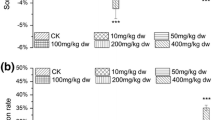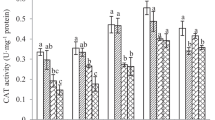Abstract
The paper reports the results of a laboratory test on the bioaccumulation and toxicological effects of sub-lethal soil concentration of copper, a widely used fungicide in organic farming, on DNA damage, a critical marker increasingly used in ecotoxicology in the earthworm Eisenia andrei. In the same experimental setting we evaluated gene expression of classical biomarker of stress induced by xenobiotic. [Heat Shock Protein 70 (HSP70) and Metallothionein (MET)], as well as genes coding for enzymes involved in detoxification of reactive oxygen species [Superoxide dismutase (SOD) and catalase (CAT)]. Additionally, expression of genes involved in the immune response were investigated: a Toll-like receptor (TLR), a receptor with cytolytic activity named Cytolytic Factor (CCF) and two antimicrobial peptides, fetidin (FET) and lysenin (LYS). Results showed significant time-dependent bioaccumulation of Cu and DNA damage at concentrations remarkably lower than those found in most agricultural soils worldwide. MET was increased as was FET and TLR. The present work gives new insights into the mechanisms of sub-lethal toxicity of copper as an environmental pollutant and in the identification of novel sub-lethal biomarkers of cellular response to the stressor such as immune response genes.




Similar content being viewed by others
References
Akira S, Uematsu S, Takeuchi O (2006) Pathogen recognition and innate immunity. Cell 124(4):783–801
Bernabò P, Gaglio M, Bellamoli F, Viero G, Lencioni V (2017) DNA damage and translational response during detoxification from copper exposure in a wild population of Chirono musriparius Chemoshpere 173:235–244
Bernard F, Brulle F, Dumez S, Lemiere S, Platel A, Nesslany F, Cuny D, Deram A, Vandenbulcke F (2015) Antioxidant responses of Annelids, Brassicaceae and Fabaceae to pollutants: a review. Ecotoxicol Environ Saf 114:273–303
Bigorgne E, Foucaud L, Lapied E, Labille J, Botta C, Sirguey C, Falla J, Rose J, Joner EJ, Rodius F, Nahmani J (2011) Ecotoxicological assessment of TiO2 byproducts on the earthworm Eisenia fetida. Environ Pollut 159(10):2698–2705
Brulle F, Mitt G, Leroux R, Lemiere S, Lepretre A (2007) The strong induction of metallothionein gene following cadmium exposure transiently affects the expression of many genes in Eisenia fetida: a trade-off mechanism? Comp Biochem Physiol Toxicol Pharmacol 144(4):334–341
Brulle F, Cocquerelle C, Wamalah AN, Morgan AJ, Kille P, Leprêtre A, Vandenbulcke F (2008) cDNA cloning and expression analysis of Eiseniafetida (Annelida: Oligochaeta) phytochelatin synthase under cadmium exposure. Ecotoxicol Environ Saf 71:47–55
Caipang CM, Lazado CC, Brinchmann MF, Kiron V (2010) Infection-induced changes in expression of antibacterial and cytokine genes in the gill epithelial cells of Atlantic cod, Gadus morhua during incubation with bacterial pathogens. Comp Biochem Physiol B 156(4):319–325
Calisi A, Lionetto MG, Schettino T (2009) Pollutant-induced alterations of granulocyte morphology in the earthworm Eisenia foetida. Ecol Environ Saf 72:1396–1377
Calisi A, Lionetto MG, Schettino T (2011) Biomarkerresponse in the earthworm Lombricus terrestris exposed to chemical pollutants. Sci Total Environ 409:4456–4464
Calisi A, Lionetto MG, DE Lorenzis E, Leomanni A, Schettino T (2014) Metallothionein induction in the coelomic fluid of the earthworm Lumbricus terrestris following heavy metal exposure: a short report. Biomed Res Int 2014:109386
Capri E, Trevisan M (2002). I metalli pesanti di origine agricola nei suoli e nelle acquesotterranee, Pitagora Editrice, Bologna, Italy
Cohen JI, Chen X, Nagy LE (2011) Redox signaling and the innate immune system in alcoholic liver disease. Antioxid Redox Signal 15(2):523–534
Cooper EL, Kauschke E, Cossarizza A (2002) Digging for innate immunity since Darwin and Metchnikoff. BioEssays 24(4):319–333
Cooper EL, Kvell K, Engelmann P, Nemeth P (2006) Still waiting for the toll? Immunol Lett 104(1–2):18–28
Dvořák J, Roubalová R, Procházková P, Rossmann P, Škanta F, Bilej M (2016) Sensing micro-organisms in the gut triggers the immune response in Eisenia andrei earthworms. Dev Comp Immunol 57:67–74
Duan X, Xu M, Zhou Y, Yan Z, Du Y, Zhang L, Zhang C, Bai L, Nie J, Chen G, Li F (2006) Effects of soil properties on copper toxicity to earthworm Eisenia fetida in 15 Chinese soils. Chemosphere 145:185–192
Engelmann P, Cooper EL, Opper B, Németh P (2011). Earthworm innate immune system. In: Karaca A (ed) Biology of earthworms. Soil biology, vol 24. Springer, Berlin, Heidelberg
EPA US (2006). Chironomid sediment toxicity test, ecological effects test guidelines, 2nd ed. Washington, DC, EPA 712-C-96-313, EPA 600/R-99/064
Fernandes MC, Cox L, Hermosin MC, Cornejo J (2003) Adsorption-desorption of metalaxyl as affecting dissipation and leaching in soils: role of mineral and organic components. Pest Manag Sci 59:545–552
Fuller-Espie SL, Bearoff FM, Minutillo MA (2011) Exposure of coelomocytes from the earthworm Eisenia hortensis to Cu, Cd, and dimethylbenz[a]anthracene: an in vitro study examining reactive oxygen species production and immune response inhibition. Pedobiologia 54(Suppl.):S31–S36
Gaetke LM, Chow CK (2003) Copper toxicity, oxidative stress, and antioxidant nutrients. Toxicology 189(1–2):147–163
Gaete H, Hidalgo ME, Neaman A, Ávila G (2010) Assessment of copper toxicity in soils using biomarkers of oxidative stress in Eisenia foetida. Quim Nova 33:566–570
Gaetke LM, Chow-Johnson HS, Chow CK (2014) Copper: toxicological relevance and mechanisms. Arch Toxicol 88(11):1929–1938
Giannetto A, Fernandes JM, Nagasawa K, Mauceri A, Maisano M, De Domenico E, Cappello T, Oliva S, Fasulo S (2014) Influence of continuous light treatment on expression of stress biomarkers in Atlantic cod. Dev Comp Immunol 44(1):30–34
Homa J, Stürzenbaum SR, Morgan AJ, Plytycz B (2007) Disrupted homeostasis in coelomocytes of Eisenia fetida and Allolobophora chlorotica exposed dermally to heavy metals. Eur J Soil Biol 43:273–280
Homa J, Rorat A, Kruk J, Cocquerelle C, Plytycz B, Vandenbulcke F (2015) Dermal exposure of Eisenia andrei earthworms: effects of heavy metals on metallothionein and phytochelatin synthase gene expressions in coelomocytes. Environ Toxicol Chem 34:1397–1404
Klobučar GI, Štambuk A, Šrut M, Husnjak I, Merkaš M, Traven L, Cvetkovi Ž (2011) Aporrectodeacaliginosa, a suitable earthworm species for field based genotoxicity assessment? Environ Pollut 159:841–849
Kowald GR, Stürzenbaum SR, Blindauer CA (2016) Earthworm Lumbricus rubellus MT-2: metal binding and cadmium inhibits worm reproduction not regeneration 283 protein folding of a true cadmium-MT. Int J Mol Sci 17(1):E65
Janeway CA Jr, Medzhitov R (2002) Innate immune recognition Annu Rev Immunol 20:197–216
Jia R, Cao LP, Du JL, Wang JH, Liu YJ (2014) Effects of carbon tetrachloride on oxidative stress, inflammatory response and hepatocyte apoptosis in common carp (Cyprinus carpio). Aquat Toxicol 152:11–19
Heijerick DG, Van Sprang PA, Van Hyfte AD (2006) Ambient copper concentrations in agricultural and natural European soils: an overview. Environ Toxicol Chem 25(3):858–864
Komárek M, Čadková E, Chrastný V, Bordas F, Bollinger C (2010) Contamination of vineyard soils with fungicides: a review of environmental and toxicological aspects. Environ Int 36:138–151
Le Roux S, Baker P, Crouch A (2016) Bioaccumulation of total mercury in the earthworm Eisenia andrei. SpringerPlus 5(1):681
Li M, Liu Z, Xu Y, Cui Y, Li D, Kong Z (2009) Comparative effects of Cd and Pb on biochemical response on DNA damage in the earthworm Eisenia fetida (Annelida Oligochaeta). Chemosphere 74:621–625
Livak KJ, Schmittgen TD (2001) Analysis of relative gene expression data using real-time quantitative PCR and the 2(-Delta Delta C(T)) method. Methods 25(4):402–408
Malley C, Nair J, Ho G (2006) Impact of heavy metals on enzymatic activity of substrate and on composting worms Eisenia fetida. Bioresosurce Technol 97:1498–1502
Mincarelli L, Vischetti C, Craft J, Tiano L (2016) DNA damage in different Eisenia andrei coelomocytes sub-populations after in vitro exposure to hydrogen peroxide. SpringerPlus 5:302
Mirlean N, Roisenberg A, Chies JO (2007) Metal contamination of vineyard soils in wet subtropics (southern Brazil). Environ Pollut 149(1):10–17
Mo XH, Qiao YH, Sun ZJ, Sun XF, Li Y (2012) Molecular toxicity of earthworms induced by cadmium contaminated soil and biomarkers screening. J Environ Sci-China 24:1504–1510
Noga EJ, Ullal AJ, Corrales J, Fernandes JM (2011) Application of antimicrobial polypeptide host defences to aquaculture: exploitation of downregulation and upregulation responses. Comp Biochem Physiol Part D 6(1):44–54
Novo M, Lahive E, Díez-Ortiz M, Matzke M, Morgan AJ, Spurgeon DJ, Svendsen C, Kille P (2015) Different routes, same pathways: molecular mechanisms under silver ion and nanoparticle exposures in the soil sentinel Eisenia fetida. Environ Pollut 205:385–393
Nadeau D, Corneau S, Plante I, Morrow G, Tanguay RM (2001) Evaluation for Hsp70 as a biomarker of effect of pollutants on the earthworm Lumbricus terrestris. Cell Stress Chaperon- 6:153
OECD (1984). Organisation for Economic Co-operation and Development guidelines for testing of chemicals. Earthworm, acute toxicity test
OECD (2001). Organisation for Economic Co-operation and Development Guideline for Testing of Chemicals, Sediment-water chironomid Toxicity Test Using Spiked Sediment
Pan JJ, Chang QS, Wang X, Son Y, Zhang Z, Chen G, Luo J, Bi YY, Chen F, Shi XL (2010) Reactive oxygen species-activated Akt/ASK1/p38 signalling pathway in nickel compound-induced apoptosis in BEAS 2B cells. Chem Res Toxicol 23:568–577
Pan J et al. (2010) Cadmium levels in Europe: implications for human health. Environ Geochem Health 32(1):1–12
Paoletti MG, Favretto MR, Stinner BR, Purrington FF, Bater JE (1991) Invertebr Bioindic Soil Use 34(1–4):341–362
Pietrzak U, McPhail DC (2004) Copper accumulation, distribution and fractionation in vineyard soils of Victoria, Australia. Geoderma 122:151–166
Plytycz B, Cygal M, Lis-Molenda U, Klimek M, Mazur AI, Duchnowski M, Morgan AJ (2011) Characteristics of immune-competent amoebocytes non-invasively retrieved from populations of the sentinel earthworm Lumbricus rubellus (Annelida; Oligochaeta; Lumbricidae) inhabiting metal polluted field soils. Ecotoxicol Environ Saf 74(4):719–726
Pruski AM, Dixon DR (2002) Effects of cadmium on nuclear integrity and DNA repair efficiency in the gill cells of Mytilus edulis. L. Acquat Toxicol 57:127–137
Sauvé S, Fournier M (2005) Age-specific immunocompetence of the earthworm Eisenia andrei: exposure to methyl mercury chloride. Ecotoxicol Environ Safe 60:67–72
Streit B (1984) Effect of high copper concentrations on soil invertebrates (earthworms and oribatid mites): experimental results and a model. Oecologia 64:381–388
Takacs V, Molnar L, Klimek B, Galuszka A, Morgan AJ, Plytycz B (2016) Exposure of Eisenia andrei (Oligochaeta; Lumbricidea) to cadmium polluted soil inhibits earthworm maturation and reproduction but not restoration of experimentally depleted coelomocytes or regeneration of amputated segments. Folia Biol 64(4):275–284
Tiano L, Littarru GP, Principi F, Orlandi M, Santoro L, Carnevali P, Gabrielli O (2005) Assessment of DNA damage in Down syndrome patients by means of a new,optimised single cell gel electrophoresis technique. Biofactors 25(1–4):187–195
Tóth G, Hermann T, Szatmári G, Pásztor L (2016a) Maps of heavy metals in the soils of the European Union and proposed priority areas for detailed assessment. Sci Total Environ 565:1054–1062
Tóth G, Hermann T, Da Slva MR, Montanarella L (2016b) Heavy metals in agricultural soils of the European Union with implications for food safety. Environ Int 88:299–309
Unrine JM, Tsyusko OV, Hunyadi SE, Judy JD, Bertsch PM (2010) Effects of particle size on chemical speciation and bioavailability of copper to earthworms (Eisenia fetida) exposed to copper nanoparticles. J Environ Qual 39:1942–1953
Vernile P, Fornelli F, Bari G, Spaguolo M, Minervini F, Lillo E, Ruggiero P (2007) Biovaialability and toxicity of pentachlorophenol in contaminated soil evaluated on coelomocytes of Eisenia andrei (Annelida: Lumbricidae). Toxicol Vitr 21:302–307
Zheng K, Liu ZT, Li YJ, Cui YB, Li M (2013) Toxicological responses of earthworm (Eisenia fetida) exposed to metal-contaminated soils. Environ Sci Pollut Res Int 20(12):8382–8390
Author information
Authors and Affiliations
Corresponding author
Ethics declarations
Conflict of interest
The authors declare that they have no conflict of interest.
Ethical approval
This article does not contain any studies with human participants or animals performed by any of the authors that require approval by the ethical committee. In fact according to present regulation studies on invertebrates, such as Eisenia andrei do not need ethical authorization.
Additional information
Publisher’s note: Springer Nature remains neutral with regard to jurisdictional claims in published maps and institutional affiliations.
Rights and permissions
About this article
Cite this article
Mincarelli, L., Tiano, L., Craft, J. et al. Evaluation of gene expression of different molecular biomarkers of stress response as an effect of copper exposure on the earthworm EIsenia Andrei. Ecotoxicology 28, 938–948 (2019). https://doi.org/10.1007/s10646-019-02093-3
Accepted:
Published:
Issue Date:
DOI: https://doi.org/10.1007/s10646-019-02093-3




